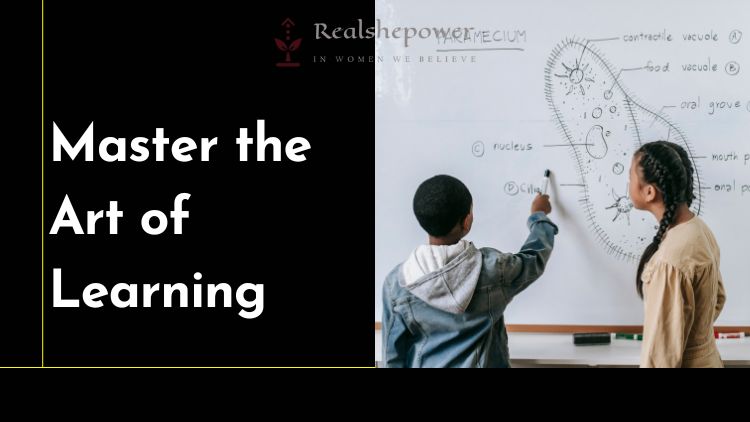6 Best Techniques for Effortless and Effective Learning!


Learning is an essential part of our lives and a continuous process that goes beyond the confines of the classroom. The ability to learn quickly and retain information can have a significant impact on our personal and professional lives. However, with so many methods to choose from, it can be challenging to determine the most effective way to learn. In this article, we’ll explore the best techniques for learning and provide practical examples to help you get started.
Table of Contents
6 best techniques for learning:
1. Repetition
Repetition is a key component of the learning process and is considered one of the most effective ways to retain information. When you repeat information multiple times, it helps to embed the information in your memory and makes it easier to recall later on. There are many ways to incorporate repetition into your learning routine, including:
- Re-reading your notes: This is a simple and straightforward way to reinforce information in your memory. Re-reading your notes regularly will help you retain the information and make it easier to recall later on.
- Summarizing information: Summarizing information can help you process and retain the information more effectively. Try to condense the information into a few key points, either in writing or orally. This will help you focus on the most important information and reinforce it in your memory.
- Repetition exercises: Try repeating the information you’ve learned out loud, or write it down several times. This will help you reinforce the information in your memory and make it easier to recall later on.
2. Practice and Application
Hands-on experience is a crucial aspect of the learning process. When you put what you’ve learned into practice, you gain a deeper understanding of the material and increase your chances of retaining the information. The hands-on approach allows you to connect the theoretical concepts with real-life applications, making the information more meaningful and memorable.
For example, if you’re learning a new recipe, you get to put your culinary skills to the test by following the instructions and making the dish. As you work through the recipe, you may encounter challenges, such as measuring ingredients accurately or adjusting the cooking time. By overcoming these challenges, you deepen your understanding of the cooking process and become more confident in your ability to make the dish.
Similarly, if you’re studying a subject like mathematics, you can work through sample problems to reinforce the concepts you’ve learned. By practicing what you’ve learned, you’ll not only increase your chances of retaining the information, but also develop your problem-solving skills.
Playing a sport is another excellent example of hands-on learning. When you play a sport, you’re forced to put into practice the techniques you’ve learned, such as dribbling, passing, or shooting. Through repetition and hands-on experience, you’ll become more skilled and confident in your abilities.
3. Visualization: The Power of Mental Imagery
Visualization is a powerful learning technique that involves creating mental images of the information you’re trying to learn. Research has shown that visualization can help you understand abstract concepts and make them more concrete, improving your ability to remember and recall the information. When you create mental images, you activate multiple parts of your brain, increasing the likelihood that the information will stick.
How to Use Visualization for Learning
Here are some tips for using visualization to enhance your learning experience:
- Create diagrams, charts, and mind maps: When you create visual representations of the information, you’re more likely to understand and remember it. Drawings and illustrations can help you see the connections between different concepts and make the information more concrete.
- Use color: Adding color to your visualizations can make them more memorable and appealing. Color can help you categorize information and see connections between different concepts.
- Make it interactive: Try to create an interactive visualization in your mind, such as a movie or simulation. This can help you understand complex ideas and make them more tangible.
- Create multiple visualizations: Each person has a unique way of visualizing information, so don’t be afraid to experiment with different visualizations until you find what works best for you.
Example: Let’s say you’re trying to learn about the structure of the human brain. You can create a diagram of the brain and label the different parts, such as the cerebellum, cortex, and hippocampus. Then, you can use color to highlight the functions of each part, creating a memorable and interactive visualization that will make the information easier to understand and recall.
4. Chunking
Chunking is a powerful learning strategy that involves breaking down complex information into smaller, more manageable pieces. The idea behind chunking is that our brains can only process a limited amount of information at a time, so by breaking down information into smaller chunks, we make it easier to understand and remember.
When you use chunking, you group related information together and focus on one concept at a time. For example, if you’re learning about a new topic, you might start by identifying the key concepts and breaking them down into smaller sub-topics. By focusing on one concept at a time, you can delve deeper into the material and fully understand each aspect before moving on to the next.
In addition to making the learning process more manageable, chunking also helps to avoid feelings of overwhelm. When faced with a large amount of information, it’s easy to feel overwhelmed and stressed, which can interfere with the learning process. By breaking down the information into smaller chunks, you can approach the material one step at a time, making it easier to stay focused and motivated.
Overall, chunking is a simple but effective learning strategy that can help you understand and retain information more easily. Whether you’re studying for a test, learning a new skill, or trying to remember important information, chunking can help you approach the material in a more structured and manageable way, reducing stress and improving your ability to learn.
5. Active recall
Active recall is a learning strategy that involves actively recalling information from memory, instead of passively reading or reviewing the material. This technique involves testing yourself on the material you have learned, whether it be through creating flashcards, taking practice quizzes, or teaching the information to someone else.
When you engage in active recall, you are forcing your brain to retrieve the information from memory, strengthening the neural connections and making it easier to recall later on. By actively testing yourself on the material, you are also identifying any gaps in your understanding and can immediately address them. This type of learning is more effective than simply reading or reviewing the material passively.
One example of active recall is creating flashcards. You can write a question on one side of the flashcard and the answer on the other. By testing yourself on the information, you are actively recalling the information and reinforcing it in your memory.
Another example is teaching the material to someone else. This not only requires you to actively recall the information, but also to organize and present it in a clear and concise manner. By doing so, you are strengthening your understanding of the material and making it easier to recall later on.
6. Sleep and Rest
Getting enough sleep and rest is one of the most important components of the learning process. Sleep is essential for the brain to consolidate memories and process information that has been learned throughout the day. This means that what we learn during the day is solidified and becomes easier to recall later on.
Studies have shown that sleep deprivation can negatively impact cognitive function, including memory and learning. A lack of sleep can also lead to fatigue, decreased motivation, and decreased attention span. On the other hand, getting enough sleep has been shown to improve memory consolidation, cognitive function, and overall learning ability.
It is recommended that adults get between seven to nine hours of sleep each night to ensure optimal brain function. Additionally, taking regular breaks throughout the day to give your brain a rest can also be beneficial. This could mean taking a short walk, meditating, or simply taking a few deep breaths.
Conclusion
Learning is an ongoing process that can have a significant impact on our personal and professional lives. By using the techniques described in this article, you can improve your ability to learn and retain information with ease. Remember, the best way to learn is by finding what works for you and incorporating it into your daily routine.
Questions for Readers
- What techniques have you found most effective for learning?
- How do you incorporate sleep and rest into your learning routine?
- How do you make the learning process less overwhelming?
- What other tips do you have for improving the learning process?
Summary: Discover the Secrets to Effortless and Effective Learning!
- Repetition: Reinforce information through repetition to increase retention.
- Practice and Application: Hands-on experience is an effective way to learn.
- Visualization: Create mental images to help understand and retain abstract concepts.
- Chunking: Break down information into smaller, manageable chunks.
- Active recall: Test yourself on the material to solidify information in memory.
- Sleep and Rest: Sleep and rest are critical to the learning process.
- Conclusion: Find what works best for you and incorporate it into your daily routine.
- Questions for Readers: Seek feedback on personal experiences and tips for improvement.
Read: 9 Surprising Truth About Adulthood: Lessons I Wish I Knew as a Teenager

You can now write for RSP Magazine and be a part of the community. Share your stories and opinions with us here.
